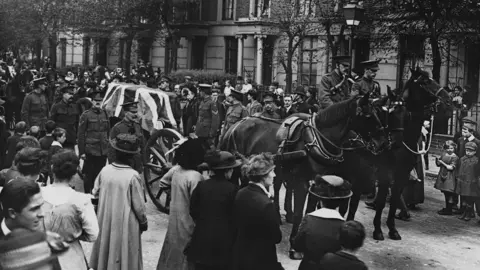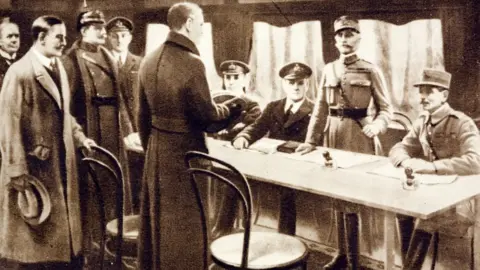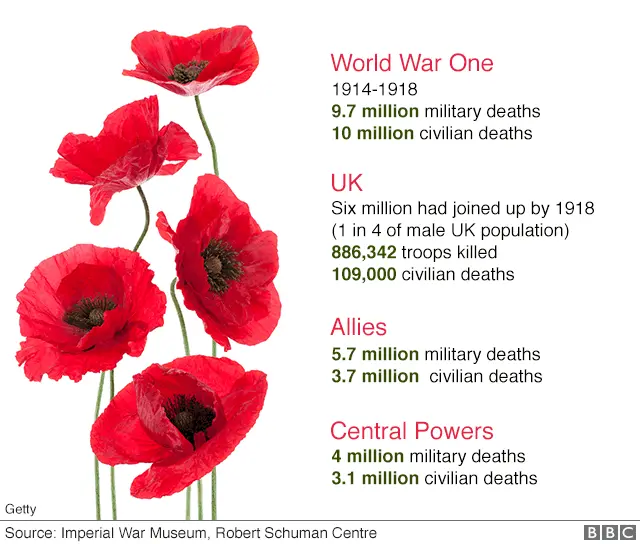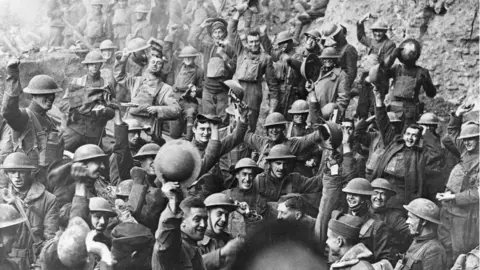World War One: Wilfred Owen and the pain of the last deaths
 Getty Images
Getty ImagesOn 11 November 1918, as news of the end of World War One spread across the world, the parents of Wilfred Owen received notice that their son had been killed in action.
The second lieutenant, who would become known as one of England's greatest war poets, had died while trying to lead his men across a canal at Ors seven days earlier.
He was one of thousands of servicemen killed in the last month of the war, and their deaths, coming as they did so close to the end of hostilities, seem to have a particularly heartbreaking quality.
The University of Oxford's professor emeritus of English Jon Stallworthy wrote in 2004 that the "socially concerned" poets of the 1930s gave Owen "the status of saint and martyr", adding that he "came to represent a generation of innocent young men sacrificed - as it seemed to a generation in unprecedented rebellion against its fathers - by guilty old men".
However, Gervase Phillips, Manchester Metropolitan University's principal lecturer in history, said the reaction at the time was quite different.
"Authors often point to the peculiar poignancy that when the Owens received the telegram informing them of Wilfred's death, all the church bells were sounding to mark the Armistice.
"Yet to those who had lived through the conflict, and experienced so much loss, I am not sure these deaths were felt any more keenly."
 Getty Images
Getty Images
Hindsight also attributes huge significance to Owen's death, but it must be remembered that, at the time, he was not well-known and so the tragedy was felt only by his family and friends - and they were far from alone in experiencing such grief.
Capt Robert Bartholomew, who was the editor of the wartime Canadian Hospital News, read about the death of his only son in a newspaper three months before the end of the war.
An account of what happened next stated that the news caused him to have a nervous breakdown and drop into a "severe depression" due to the "mental shock".
He had previously written that the parents of those killed would feel "sorrow and pain", but would also "be able to look back with a feeling of pride and say: 'They died for God, for King and Country'".
And despite his severe reaction to the loss of his son, that sentiment did not seem to change, as a few weeks after hearing the news, an editorial in the publication declared with pride that "sons have died by thousands and will continue to die by thousands if necessary, until victory is assured".
 Getty Images
Getty ImagesMr Phillips said while a modern reader might judge such a stance as bravado, and more widely see those deaths in the final months of the war as futile, it was important to remember there was no "unconditional surrender" at the end of the war and an Allied victory was far from assured until its very last moments.
He said the Armistice "was not certain until about 05:00 on the morning of the 11th", though talk of it had been "widespread throughout the British Expeditionary Force (BEF) since at least 9 November".
"Think of the ending of the war as a process, rather than a distinct moment," the academic said.
"Bulgaria agreed an armistice with the Allies on 30 September, the Ottoman Empire agreed one on 30 October and the Habsburgs (the rulers of the Austro-Hungarian Empire) on 3 November.
"The 'direction of travel' was clear, [but] the Germans still hoped to negotiate the best possible terms for a ceasefire right up until the end.
"So the BEF's victory at the [second] Battle of the Sambre on 4 November, where Owen was killed, the American advance to the heights overlooking Sedan and the French capture of the strategic railhead at Hirson by 9 November, were all instrumental in persuading the German delegation to agree to the Armistice."

Confirming the actual number of Allied deaths in the run-up to the Armistice is problematic.
Statistics of the Military Effort of the British Empire, a book published in 1922, listed 6,064 deaths between 1 and 11 November 1918, with a further 2,008 men listed as missing, but the Commonwealth War Graves Commission's (CWGC) database now records 15,002 graves with death dates in those 11 days.
Mr Phillips said "recordkeeping at the front was, inevitably, suspect [as] it wasn't a great environment for bureaucracy, and trying to establish the record retrospectively, on the basis of documentation that may be incomplete or inaccurate, is no easy task".
He said thousands of soldiers "effectively disappeared" towards the end of the war and "very often no-one knew exactly what had befallen them or precisely when".
"Some subsequently turned up - in a hospital or perhaps in a POW camp - but many were simply recorded as 'missing, presumed killed' - and they still are."
 Getty Images
Getty ImagesAmong those who died in those last days were three soldiers who were posthumously awarded the Victoria Cross.
Sgt Hugh Cairns was killed after capturing a machine-gun at Valenciennes on 2 November, while two days later, 2nd Lt James Kirk and Acting Lt Col James Marshall died in the same action as Owen.
Lt Kirk was killed while supporting troops crossing the Oise canal, and Col Marshall died leading his men across a bridge on the waterway.
But far from being seen as needless, their deaths were recorded in the press with the same pride as any of the hundreds that had come before and were welcomed in the same way as the others by the general public, Mr Phillips said.
Such a reaction was understandable, given that the end of the war came as something of a surprise to most of both those who were fighting and their families.
Mr Philips said the most surprising thing was "how suddenly the war stopped on the dot".
An account by Gen Sir Archibald Montgomery recorded that "the firing, which had been heavy all the morning, continued until three minutes to 11:00 when it ceased for a short period and then broke out in a final crash".
He also recorded the "final act" of a German machine-gunner, who, at two minutes to 11:00, had "fired off a complete belt without pause", before standing, taking off his his helmet, bowing and walking "slowly to the rear".
 Getty Images
Getty ImagesHowever, Mr Phillips said the war had been a "brutalising business" and there were also "some instances" where there was "a desire not to stop fighting".
An account of the BEF's 8th Division's actions includes details of a company coming across an occupied German post at precisely 11:00.
"The men were persuaded with difficulty to refrain from attacking it," the account records, adding that it was "their earnest contention being that no-one needs know anything about it and that it seemed a pity not to kill a few more Germans while they had the chance".
It also must be remembered that the war continued to claim lives after the Armistice.
News of the ceasefire took time to filter to all the areas involved, and fighting continued for some time after 11:00 in places such as Russia and Mesopotamia (an area that covers parts of modern-day Iraq, Kuwait, Saudi Arabia, Syria and Turkey).
A large number of soldiers also succumbed to wounds or illness in the days and weeks following the end of the war.
The CWGC database lists 10,991 graves with death dates between 12 and 30 November 1918 and a further 47,510 listed between 1 December 1918 and 10 January 1920, the day the Treaty of Versailles, the formal document that officially ended the war, came into effect.
And so the Armistice might have silenced the guns, but it did not entirely stop the fatalities.
